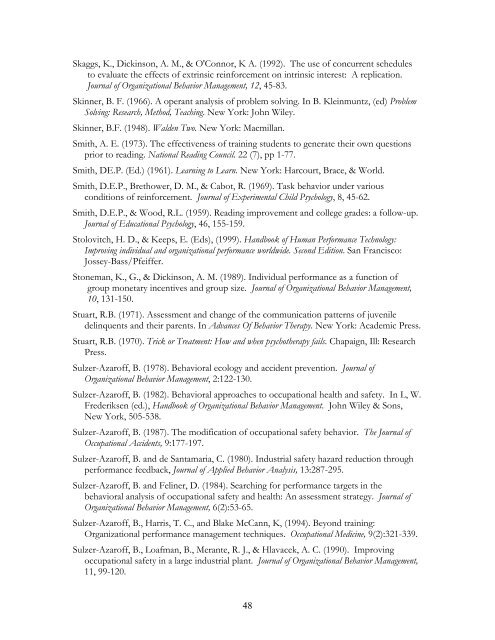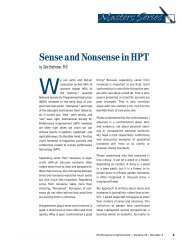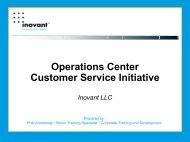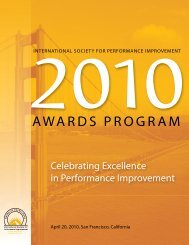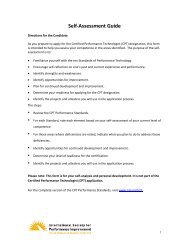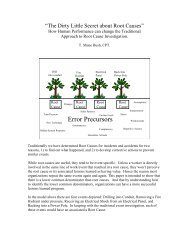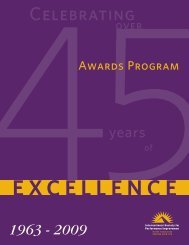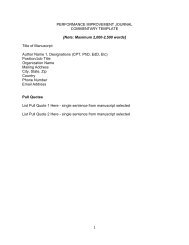Yes We Can! - International Society for Performance Improvement
Yes We Can! - International Society for Performance Improvement
Yes We Can! - International Society for Performance Improvement
You also want an ePaper? Increase the reach of your titles
YUMPU automatically turns print PDFs into web optimized ePapers that Google loves.
Skaggs, K., Dickinson, A. M., & O'Connor, K A. (1992). The use of concurrent schedules<br />
to evaluate the effects of extrinsic rein<strong>for</strong>cement on intrinsic interest: A replication.<br />
Journal of Organizational Behavior Management, 12, 45-83.<br />
Skinner, B. F. (1966). A operant analysis of problem solving. In B. Kleinmuntz, (ed) Problem<br />
Solving: Research, Method, Teaching. New York: John Wiley.<br />
Skinner, B.F. (1948). Walden Two. New York: Macmillan.<br />
Smith, A. E. (1973). The effectiveness of training students to generate their own questions<br />
prior to reading. National Reading Council. 22 (7), pp 1-77.<br />
Smith, DE.P. (Ed.) (1961). Learning to Learn. New York: Harcourt, Brace, & World.<br />
Smith, D.E.P., Brethower, D. M., & Cabot, R. (1969). Task behavior under various<br />
conditions of rein<strong>for</strong>cement. Journal of Experimental Child Psychology, 8, 45-62.<br />
Smith, D.E.P., & Wood, R.L. (1959). Reading improvement and college grades: a follow-up.<br />
Journal of Educational Psychology, 46, 155-159.<br />
Stolovitch, H. D., & Keeps, E. (Eds), (1999). Handbook of Human Per<strong>for</strong>mance Technology:<br />
Improving individual and organizational per<strong>for</strong>mance worldwide. Second Edition. San Francisco:<br />
Jossey-Bass/Pfeiffer.<br />
Stoneman, K., G., & Dickinson, A. M. (1989). Individual per<strong>for</strong>mance as a function of<br />
group monetary incentives and group size. Journal of Organizational Behavior Management,<br />
10, 131-150.<br />
Stuart, R.B. (1971). Assessment and change of the communication patterns of juvenile<br />
delinquents and their parents. In Advances Of Behavior Therapy. New York: Academic Press.<br />
Stuart, R.B. (1970). Trick or Treatment: How and when psychotherapy fails. Chapaign, Ill: Research<br />
Press.<br />
Sulzer-Azaroff, B. (1978). Behavioral ecology and accident prevention. Journal of<br />
Organizational Behavior Management, 2:122-130.<br />
Sulzer-Azaroff, B. (1982). Behavioral approaches to occupational health and safety. In L, W.<br />
Frederiksen (ed.), Handbook of Organizational Behavior Management. John Wiley & Sons,<br />
New York, 505-538.<br />
Sulzer-Azaroff, B. (1987). The modification of occupational safety behavior. The Journal of<br />
Occupational Accidents, 9:177-197.<br />
Sulzer-Azaroff, B. and de Santamaria, C. (1980). Industrial safety hazard reduction through<br />
per<strong>for</strong>mance feedback, Journal of Applied Behavior Analysis, 13:287-295.<br />
Sulzer-Azaroff, B. and Feliner, D. (1984). Searching <strong>for</strong> per<strong>for</strong>mance targets in the<br />
behavioral analysis of occupational safety and health: An assessment strategy. Journal of<br />
Organizational Behavior Management, 6(2):53-65.<br />
Sulzer-Azaroff, B., Harris, T. C., and Blake Mc<strong>Can</strong>n, K, (1994). Beyond training:<br />
Organizational per<strong>for</strong>mance management techniques. Occupational Medicine, 9(2):321-339.<br />
Sulzer-Azaroff, B., Loafman, B., Merante, R. J., & Hlavacek, A. C. (1990). Improving<br />
occupational safety in a large industrial plant. Journal of Organizational Behavior Management,<br />
11, 99-120.<br />
48


